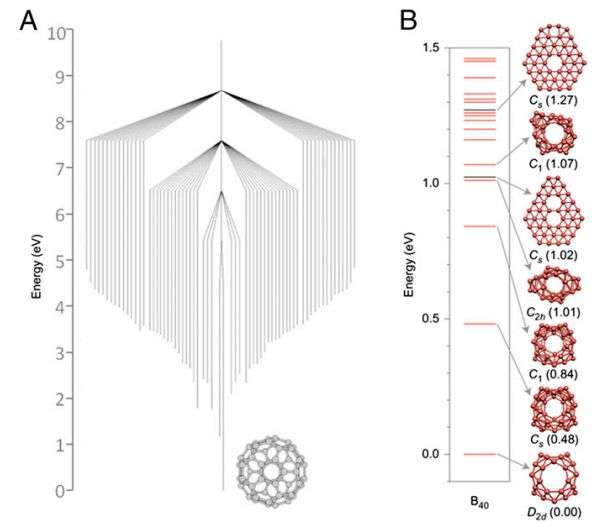January 5, 2016 report
Criteria to predict experimentally stable allotropes

(Phys.org)—A group of researchers from France, the U.K. and Florida proposes criteria to determine whether an allotrope is experimentally feasible. They use theoretical carbon allotropes, penta-graphene and Haeckelites, as examples and demonstrate why penta-graphene, contrary to recent research, is not experimentally practical while Haeckelites could be isolated in the presence of charge transfer ions. Their study appears in The Proceedings of the National Academy of Science.
Christopher P. Ewels, Xavier Rocquefelte, Harold W. Kroto, Mark J. Rayson, Patrick R. Briddon, and Malcolm I. Heggie's work responds to Zhang, et al.'s February 2015 article in The Proceedings of the National Academy of Sciences reporting that penta-graphene is a new allotrope of carbon based on calculations that confirm its dynamical, thermal, and mechanical stability. Ewels, et al. disagree that this is an experimentally possible allotrope and believe that, while penta-graphene may exhibit properties that place it within a local energy minimum, it will tend toward spontaneous formation of graphene.
Graphene is made of a network of hexagonal carbon rings, characterized by carbon atoms that are sp2 hybridized. Fullerenes, C60, are a network of hexagonal and pentagonal carbons and are a mixture of sp2 and sp3 hybridized carbons. Zhang, et al. conducted molecular studies to demonstrate that carbon should also be able to form a network of pentagonal carbon rings in the form of Cairo pentagonal tiling. This structure consists of out-of-plane distorted ethylene units connected via sp3carbon linkers.
However, Ewels, et al. show that while Cairo pentagonal tiling is geometrically enticing, it is not experimentally feasible to form a carbon allotrope due to several criteria that are based largely on the potential energy landscape of possible carbon allotropes. They summarize their criteria as: Stable allotropes must reside in a potential energy minimum; surrounding "wells" must be higher in energy such that a kind of "funneling" toward an energy minimum can occur; and theoretical carbon allotropes must have some kind of energy barrier to keep them from readily converting into a more stable structure. Penta-graphene, while it may sit in a relative energy minimum, is a high-energy structure. It is significantly less stable than graphene, amorphous carbon, most nanotubes, and C60.
First, rather than being the center of a "funnel" in an energy landscape of isomers, penta-graphene is part of the "funnel" that leads to graphene as the most stable structure. Their studies showed that transformation from penta-graphene to graphene via bond rotations is thermodynamically favored at each step. Importantly, their studies of the energy landscapes for crystalline carbon allotropes predict these structures will "funnel" toward fully sp2 or sp3 hybridized carbons.
Secondly, penta-graphene is not kinetically or chemically stable. Upon heating, notably in the presence of structural defects, penta-graphene does not maintain its structure for an appreciable timeframe. And, theoretical studies with O2 indicate that penta-graphene would likely undergo exothermic spontaneous oxidation upon exposure to air.
Ewels, et al. then subjected another theoretical carbon structure, called Haeckelites, to their model. These carbon allotropes were proposed fifteen years ago, and while much research has been done on Haeckelites, they have never been experimentally isolated. They were proposed as a type of graphite-like planar sp2-carbon structure made predominantly of pentagonal and heptagonal carbons.
Using their criteria for determining feasible carbon allotropes, Ewels, et al. found that three theoretical Haeckelite structures that would be less stable than graphene become more stable when doped with a metal cation. This is based on experimentally isolated structural analogs of metal borocarbides, and indicates that Haeckelites containing a charge transfer ion are experimentally feasible.
This theoretical work calls into question some conclusions on whether penta-graphene is a viable candidate as a stable carbon allotrope and proposes criteria that could be generally applied to evaluate future isomeric structures.
More information: Christopher P. Ewels et al. Predicting experimentally stable allotropes: Instability of penta-graphene, Proceedings of the National Academy of Sciences (2015). DOI: 10.1073/pnas.1520402112
Abstract
In recent years, a plethora of theoretical carbon allotropes have been proposed, none of which has been experimentally isolated. We discuss here criteria that should be met for a new phase to be potentially experimentally viable. We take as examples Haeckelites, 2D networks of sp2-carbon–containing pentagons and heptagons, and "penta-graphene," consisting of a layer of pentagons constructed from a mixture of sp2- and sp3-coordinated carbon atoms. In 2D projection appearing as the "Cairo pattern," penta-graphene is elegant and aesthetically pleasing. However, we dispute the author's claims of its potential stability and experimental relevance.
Journal information: Nature , Proceedings of the National Academy of Sciences , Nature Chemistry
© 2016 Phys.org





















